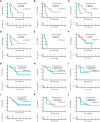A Nomogram Model to Predict Post-Progression Survival in Esophageal Squamous Cell Carcinoma Patients With Recurrence After Radical Resection
- PMID: 35875105
- PMCID: PMC9300830
- DOI: 10.3389/fonc.2022.925685
A Nomogram Model to Predict Post-Progression Survival in Esophageal Squamous Cell Carcinoma Patients With Recurrence After Radical Resection
Abstract
Background: Esophageal squamous cell carcinoma (ESCC) is characterized clinically by frequent recurrence, leading to a poor prognosis after radical surgery. The aim of this study was to identify a prognostic nomogram to predict the post-progression survival (PPS) of ESCC patients based on the features of primary tumor and recurrence.
Methods: A total of 234 ESCC patients who underwent recurrence after radical surgery were enrolled in this study. The independent prognostic factors screened by the univariate and multivariate Cox regression analysis were subsequently used to construct a nomogram. The predictive performance of the nomogram was evaluated with the concordance index (C-index), decision curve, and the area under the receiver operating characteristic curve (AUC) and validated in two validation cohorts. The Kaplan-Meier curves of different recurrence patterns were analyzed.
Results: The prognostic nomogram of PPS was established by integrating independent prognostic factors, including age, body mass index, number of lymph node dissection, recurrence pattern, and recurrence treatment. The nomogram demonstrated good performance, with C-index values of 0.756, 0.817, and 0.730 for the training and two validation cohorts. The 1-year AUC values were 0.773, 0.798, and 0.735 and 3-year AUC values were 0.832, 0.871, and 0.791, respectively. Furthermore, we found that patients with bone metastasis displayed the worst PPS compared to other isolated recurrence patterns.
Conclusion: We constructed a nomogram to reliably predict PPS, which would be valuable to provide individual managements for ESCC patients after radical surgery.
Keywords: esophageal squamous cell carcinoma (ESCC); nomogram; post-progression survival; prognostic model; recurrence.
Copyright © 2022 Leng, Cui, Chen, Wang, Yang, Wen, Fu and Liu.
Conflict of interest statement
The authors declare that the research was conducted in the absence of any commercial or financial relationships that could be construed as a potential conflict of interest.
Figures







Similar articles
-
A Novel Nomogram to Predict Survival in Patients With Recurrence of Pancreatic Ductal Adenocarcinoma After Radical Resection.Front Oncol. 2020 Sep 3;10:1564. doi: 10.3389/fonc.2020.01564. eCollection 2020. Front Oncol. 2020. PMID: 33014805 Free PMC article.
-
Clinical significance of Osaka prognostic score based on nutritional and inflammatory status in patients with esophageal squamous cell carcinoma.BMC Cancer. 2022 Mar 17;22(1):284. doi: 10.1186/s12885-022-09406-6. BMC Cancer. 2022. PMID: 35300627 Free PMC article.
-
Clinicopathological significance of cancer stem cell marker CD44/SOX2 in esophageal squamous cell carcinoma (ESCC) patients and construction of a nomogram to predict overall survival.Transl Cancer Res. 2024 Jun 30;13(6):2971-2984. doi: 10.21037/tcr-23-2313. Epub 2024 May 30. Transl Cancer Res. 2024. PMID: 38988936 Free PMC article.
-
Increased prognostic value of clinical-reproductive model in Chinese female patients with esophageal squamous cell carcinoma.World J Gastroenterol. 2022 Apr 7;28(13):1347-1361. doi: 10.3748/wjg.v28.i13.1347. World J Gastroenterol. 2022. PMID: 35645543 Free PMC article.
-
Development and validation of a nomogram to predict overall survival of T1 esophageal squamous cell carcinoma patients with lymph node metastasis.Transl Oncol. 2021 Aug;14(8):101127. doi: 10.1016/j.tranon.2021.101127. Epub 2021 May 18. Transl Oncol. 2021. PMID: 34020370 Free PMC article.
References
-
- Kroll D, Borbely YM, Dislich B, Haltmeier T, Malinka T, Biebl M, et al. . Favourable Long-Term Survival of Patients With Esophageal Cancer Treated With Extended Transhiatal Esophagectomy Combined With En Bloc Lymphadenectomy: Results From a Retrospective Observational Cohort Study. BMC Surg (2020) 20(1):197. doi: 10.1186/s12893-020-00855-z - DOI - PMC - PubMed
LinkOut - more resources
Full Text Sources

